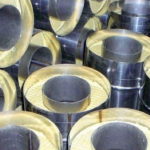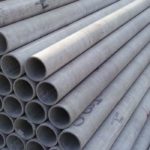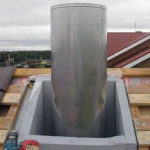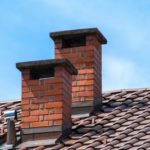The stove and chimney are integral components of the system. If the firebox is folded incorrectly, it can smoke, heat up poorly, the same can be said about the chimney. One of the main conditions for the correct functioning of the gas exhaust duct is the diameter of the chimney. A certain thrust must be created in it, this can only be achieved by coordinating the power of the boiler and the smoker itself.
How the smoke outlet works
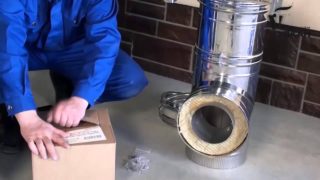
The device for the smoke exhaust channel consists of a pipe, which can be of a circular cross-section of different diameters or a square, rectangular shape. The system is connected to the boiler equipment through the outlet. In addition to the removal of gases, some of the oxygen enters the furnace through the smoke box, which contributes to the combustion process.
The main parts of the flue gas outlet:
- Pipe channel. This is the main part of the design. As a rule, the inside of the device should have smooth walls so that soot settles less on them and there is no additional resistance to air flow.
- Gate damper. This element is installed at the beginning of the stroke, with the help of it it is possible to partially or completely block the channel, achieving a certain thrust force. The damper helps to keep the heat inside the room when the stove is well heated.
- The condensate trap is a necessary part of the chimney, where moisture gets, deposited on the inner walls when cooling the steam, which is always present in the smoke. The location of this device in the general scheme is usually at the bottom of the vertical riser.
- Inspection window - a small hole in the flue gas outlet, covered with a door, so that you can view the channel for the presence of soot, tar deposits and foreign objects in it and remove them if necessary.
The thrust inside the gas exhaust system occurs due to the fact that the pressure is different at the top and bottom of the channel. The larger the chimney, the faster the smoke comes out of the stove.
If everything is assembled correctly, combustion products cannot get into the heated room.
What pipes are made of
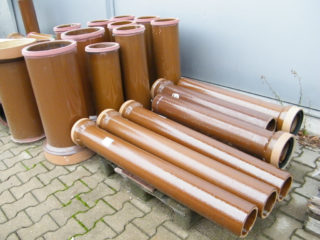
The four main building materials from which chimneys are made: galvanized steel, ceramics, stainless steel, clay-based bricks.
Square chimneys, built of bricks in accordance with all standards for performing furnace work, are distinguished by high fire safety and the lack of the ability to accumulate soot deposits on the walls. In addition, the material is quite heat-intensive and strong by mechanical standards. The only drawback of brick is its susceptibility to destruction due to the destructive effect of chemical reactions between water and sulfur oxide.
Steel chimneys are convenient in that they allow you to get a channel of any configuration. The disadvantage is a short service life, since the metal tends to burn out and corrode. Stainless elements are more resistant.
Pipes made of ceramic material can easily withstand elevated temperatures and the aggressive environment of precipitating condensate. The assembly of such a structure is difficult due to the large mass of elements, where a frame made of steel rods is used for strength.
Varieties of systems

The type of supporting structure determines the category of a particular flue gas outlet. This indicator can be distinguished:
- Self-supporting structures. The basis here is made up of sandwich chimneys. A feature of the latter is the ease of installation on a roof covering, where the base of the pipe rests and is fixed in the interior of the building. The systems have many application restrictions ranging from the temperature of the combustion products to chemical instability.
- Near-facade structures are fixed directly to the load-bearing walls of the building, so there is no need for an additional foundation. The modules that make up the chimney are easy to replace, so this type of chimney is considered the most economical.
- Column-shaped chimneys are brick structures, at the base of which a powerful foundation is laid, usually round or square arrays, vertically going up. There are columns made of metal, where several buildings are assembled into a single ensemble, the so-called multi-barreled system.
- Chimneys assembled according to the truss principle have found application in areas with unstable seismic conditions, they have additional supports.
- Mast structures consist of a support tower stretched by cables, where one or more pipes pass inside.
The chimneys, which are of great height, experience colossal wind loads. To make such structures more stable, it is imperative to fix them at the middle and highest point or along the entire length with brackets if the pipe is near the load-bearing wall of the house.
Flue gas discharge parameters
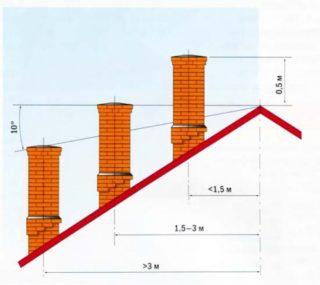
The main parameters of the chimney include its internal configuration, diameter or cross-sectional area and height. All these parameters are selected in the complex in order to create the necessary traction for one or another boiler equipment.
The oval-shaped section has the property of twisting the combustion products in a spiral direction due to the uneven heating of the vertical walls, while they receive additional acceleration.
A rectangular section works well, but provided that the inside of the surface is close to ideal in terms of smoothness. Otherwise, roughness and unevenness lead to inhibition of the flow inside.
The diameter and height of the structure must correspond to the capacity of the heating installation with which it is supposed to heat the house.
How to calculate the diameter of the chimney
Different heating devices have their own requirements for traction. It is impossible to apply the same calculation method for a fireplace, stove and gas boiler, since the volume and design of the furnaces are different, the amount of combustion products and the rate of their formation are different. For the practical determination of the pipe diameter for all types of equipment, their own formulas and rules have been developed.
For a sauna stove
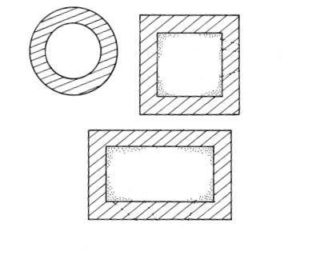
Since the designed sauna stove has a firebox, it is easiest to calculate the diameter of the chimney for it, starting from the size of the combustion compartment. A regularity has been experimentally derived that when fuel is burned, a certain amount of gases is released, the volume of which will effectively go out if the proportion of 10 to 1 is observed, where the first number of units characterize the size of the furnace, and the second number is the cross-sectional area of the round pipe.
If we are talking about a smoke made of bricks, no matter of square or rectangular shape, its inner passage should be larger than the ashtray door or ash pan chamber. The excess should be about 1.5 times.
The minimum permissible size of a square duct for a low-power furnace should be 140 mm / 140 mm. The length of the chimney for a wood-burning stove in a bath can be arbitrary.
For boiler gas equipment
A gas boiler, like other heating installations, is characterized by a capacity expressed in kilowatts of thermal energy per unit area.The diameter or internal dimension of the pipe directly depends on this power.
The chimney rate for a gas boiler of a rectangular channel must comply with the rule that for 1 kilowatt of unit power there is 5.5 cm² of passage. The diameter of the round flue must not be narrower than the diameter of the combustion chamber outlet on the gas system.
Calculation of a chimney for a wood-burning stove
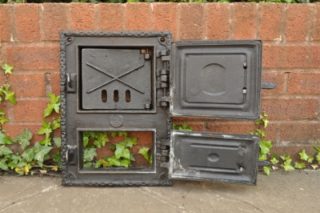
Where, B - the speed at which firewood burns (depends on the type of wood and is determined from the tables), V - the volume of air required for the combustion process, t - temperature of gases in the pipe;
Having determined the total area of the passage, based on the obtained diameter, it is easy to calculate the inner sides of a square or rectangular smoker.
The rule is also relevant here that the inner size cannot be less than the size of the blower door.
Connecting a collective smoke duct
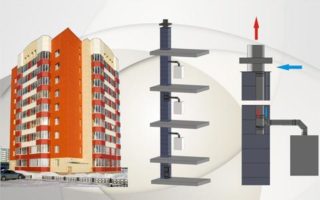
The need to have one smoker for several households arises if there is a need to save money, space, or it is not possible to organize the exhaust gas removal system in a different way. From a technical point of view, this is a perfectly acceptable option and such structures are effectively operated. In this case, it is necessary to consider two options for tasks:
- Connection to the device of the same type of heating devices.
- Connection to the line of fundamentally different heating installations, for example, a gas boiler and a brick fireplace.
In the first case, there is no difficulty in connecting the equipment to a common channel, since for such devices it is possible to calculate a smoke channel for one thrust indicator, at which all units will work correctly.
In the second option, it will not be possible to coordinate the devices, since the chimney for the fireplace should occupy 1/10 of the furnace area, and this is too much for the boiler. The result is either excessive or insufficient thrust for one of the devices, which is fraught with negative consequences.
The most correct solution would be to use a two-channel system. Its essence is that the inner space of the pipe is divided into two channels, each of which is designed for its own heating equipment.

